![]()
![]()
![]()
Use LEFT and RIGHT arrow keys to navigate between flashcards;
Use UP and DOWN arrow keys to flip the card;
H to show hint;
A reads text to speech;
55 Cards in this Set
- Front
- Back
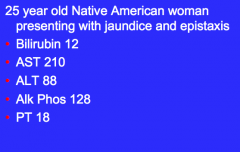
What is the percentage of liver disease in Native Americans?
What percent of all deaths from chronic liver disease in Native Americans? |
41% 65% |
|

|
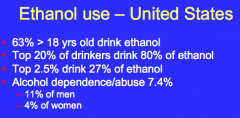
|
|
|
What percent of chronic liver disease is alcoholic liver disease?
What percent of deaths from cirrhosis? |
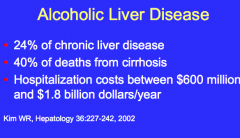
|
|
|
What is the number one and number two cause of chronic liver disease in the US? |
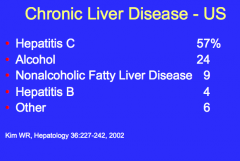
|
|
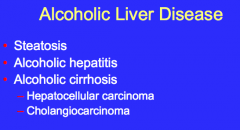
|

|
|
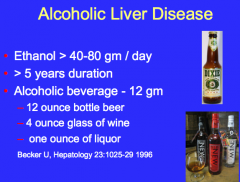
|

|
|

|
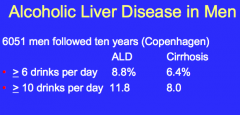
|
|
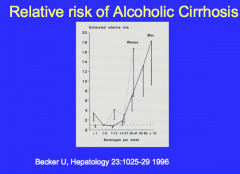
|

|
|

|

|
|
|
What age for alcoholic hepatitis? How much alcohol is required and for how many years?
Rapid onset of what clinical sign? Other symptoms?
What will be enlarged and tender on physical exam?
Compare the AST and ALT ratios. |

|
|
|
Alcoholic hepatitis: Will you see leukocytosis? Elevated INR?
|

|
|

|

|
|
|
Is there a well understood pathogenesis of alcoholic hepatitis? |
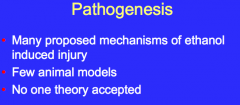
Not really. |
|
|
What gene was associated with increased susceptibility of to ALD in East Asians? What is the polymorphism in caucasians? |

|
|
|
What two chemicals cause intestinal injury and increased permeability resulting in endotoxemia? What does endotoxemia result in an inflammatory response by? |

|
|
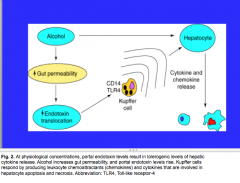
|

|
|
|
Two hit theory:
1st Hit: _______ liver |
1st Hit: Fatty liver |
|

What are these all used for in alcoholic hepatitis? |
Predictors of survival |
|

|

|
|
|
Identify the numbers for the Glasgow Alcoholic Hepatitis Score (1, 2, 3)
Age WBC BUN INR Bilirubin |

|
|

|

KNOW WHAT MELD IS FOR THE EXAM! DON'T KNOW FORMULA, JUST KNOW WHAT IT DEPENDS ON |
|

|

|
|
|
What are three advanced liver diseases in alcoholics? |

|
|

|

|
|

|
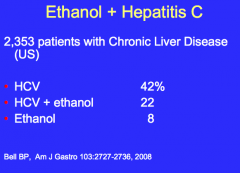
|
|
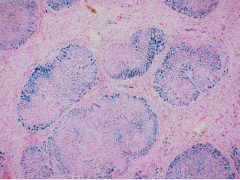
What is the condition? What percent of patients with this condition had ethanol abuse? What was its effect on cirrhosis and survival compared to those without ethanol abuse? |

|
|
|
Patients with which mutation had more advanced fibrosis and cirrhosis?
Heterozygosity of which gene likely plays a role in increasing iron loading and liver injury? |

|
|
|
Alcoholic cirrhotic patients with which mutations had increased hepatic iron scores and higher rates of HCC? |

|
|

What is shown here? |
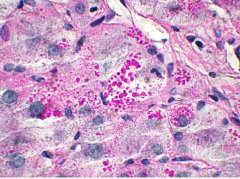
a1AT deficiency |
|
|
What is phenotype MZ? |

|
|
|
In patients with alpha one antitrypsin deficiency, what percent had chronic hepatitis associated with alcohol? What percent had alcoholic cirrhosis? |
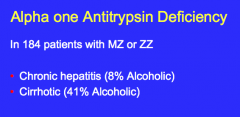
|
|
|
What are the three most important environmental factors determining ALD risk? |
Ethanal patterns Obesity and associated hyperglycemia |
|
|
Obviously, you want to avoid alcohol and optimize nutrition, but what are two drug therapies for treatment of ALD? |
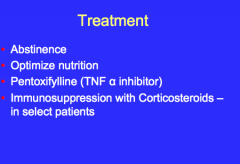
Pentoxifylline Immunsuppression with corticosteroids |
|
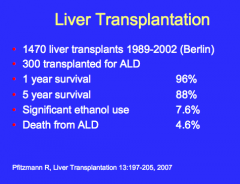
|

|
|

|

|
|

Therapy = nutrition and abstinence |

|
|
|
Draw the pathogenic pathways of alcoholic liver disease interrelationships. |

|
|
|
What do all changes in alcoholic liver disease begin in? What can accumulate even after moderate intake of alcohol?
What is the gross appearance of the liver in someone with chronic alcoholism and fatty liver.
Is fatty change reversible? |
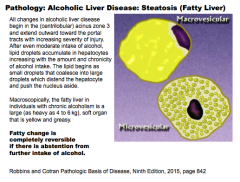
|
|
|
“Alcohol causes steatosis, dysfunction of ___ and cellular membranes, ___, and oxidative stress. At millimolar concentrations, alcohol directly affects ___ and mitochondrial function and membrane fluidity. Hepatocellular steatosis results from (2) impaired assembly and secretion of ___; and (3) increased peripheral catabolism of __, thus releasing free fatty acids into the circulation.” |
“Alcohol causes steatosis, dysfunction of mitochondrial and cellular membranes, hypoxia, and oxidative stress. At millimolar concentrations, alcohol directly affects microtubular and mitochondrial function and membrane fluidity. Hepatocellular steatosis results from (2) impaired assembly and secretion of lipoproteins; and (3) increased peripheral catabolism of fat, thus releasing free fatty acids into the circulation.” |
|
|
What three major things is alcoholic hepatitis characterized by? (histology)
What is the major difference between alcoholic hepatitis and viral/autoimmune hepatitis? |

|
|
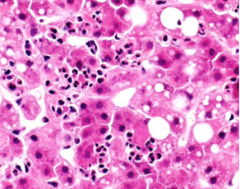
What condition is shown on the slide here? Identify neutrophils and Mallory Denk bodies. |

|
|
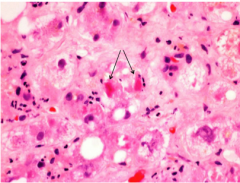
What are the arrows pointing to?
How long can they persist after exposure to alcohol has ended? |
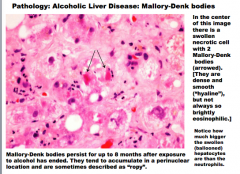
Mallory-Denk bodies |
|
|
Alcoholic Liver Disease: Hepatitis
“____ (the major intermediate metabolite of alcohol) induces lipid peroxidation and acetaldehyde-protein adduct formation, disrupting cytoskeletal and membrane function. Alcohol impairs hepatic metabolism of ____, which decreases glutathione levels, thereby sensitizing the liver to _____ injury. The induction of cytochrome P-450 enzymes in the liver by alcohol increases alcohol catabolism in the ____ and enhances the conversion of other drugs (e.g., acetaminophen) to toxic metabolites. Alcohol stimulates the release of ____ from sinusoidal endothelial cells, causing vasoconstriction and contraction of activated, myofibroblastic stellate cells, leading to a decrease in hepatic sinusoidal _____. Alcohol causes the release of bacterial ____ from the gut into the portal circulation, inducing inflammatory responses in the liver, due to the activation of NF-κB, and release of ___, ___, and ___.” |
“Acetaldehyde (the major intermediate metabolite of alcohol) induces lipid peroxidation and acetaldehyde-protein adduct formation, disrupting cytoskeletal and membrane function. Alcohol impairs hepatic metabolism of methionine, which decreases glutathione levels, thereby sensitizing the liver to oxidative injury. The induction of cytochrome P-450 enzymes in the liver by alcohol increases alcohol catabolism in the endoplasmic reticulum and enhances the conversion of other drugs (e.g., acetaminophen) to toxic metabolites. Alcohol stimulates the release of endothelins from sinusoidal endothelial cells, causing vasoconstriction and contraction of activated, myofibroblastic stellate cells, leading to a decrease in hepatic sinusoidal perfusion. Alcohol causes the release of bacterial endotoxin from the gut into the portal circulation, inducing inflammatory responses in the liver, due to the activation of NF-κB, and release of TNF, IL-6, and TGF-α.” |
|

What is the ear lies pattern of hepatic fibrosis in alcoholic liver disease?
What does fibrosis begin with? |

|
|
|
What does fibrosis start and spread to?
What is the process of capillarization? |

|
|
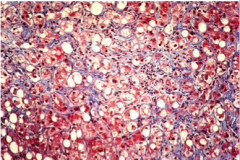
Pericellular fibrosis. What is the characteristic pattern? |

|
|
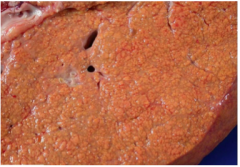
When alcohol use continues without interruption over the long term, nodules of regenerating hepatocytes (regenerative nodules) come to be separated by broad bands of _____ tissue. The continual subdivision of established nodules by new webs of perisinusoidal scarring leads to a classic _____ (Laennec) cirrhosis first described for end-stage alcoholic liver disease. |
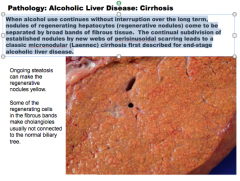
|
|
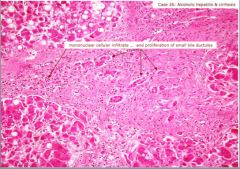
What is the condition? |
Cirrhosis |
|
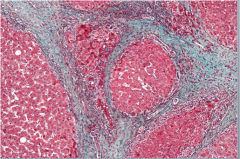
Cirrhosis with ongoing necrosis of hepatocytes is called what? |
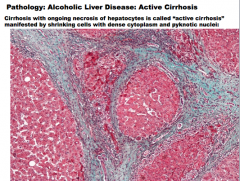
Active cirrhosis |
|
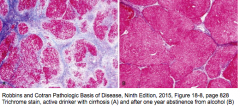
Is cirrhosis reversible? |
Yes Early stages of scarring can regress with cessation of alcohol use, but the farther along toward cirrhosis the liver gets, the more vascular derangements prevent a full restoration of normal. Complete regression of alcoholic cirrhosis, while reported, is rare: |
|
|
What percent of alcoholics develop cirrhosis? Men or women more susceptible? Why? Which race is more susceptible? Which enzyme found in 50% of Asians has a very low activity? |
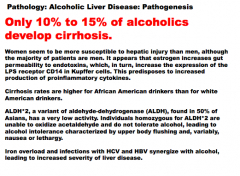
|
|
|
What can cause hepatomegaly with mild elevations of serum bilirubin and alkaline phosphatase levels? Is severe hepatic dysfunction unusual?
|
Hepatic steatosis |
|
|
Alcoholic hepatitis tends to appear _____, usually following a bout of heavy drinking. Symptoms and laboratory manifestations may range from minimal to acute liver failure. Between these two extremes are the nonspecific symptoms of malaise, _____, weight loss, upper abdominal discomfort, and tender _____, and the laboratory findings of hyperbilirubinemia, elevated serum aminotransferases and alkaline phosphatase, and often a neutrophilic leukocytosis. In contrast to other chronic liver diseases where serum ALT tends to be higher than serum AST, serum ___ levels tend to be higher than serum ___ levels in a 2:1 ratio or higher in alcoholic liver disease. This can sometimes be helpful in the differential diagnosis of chronic liver injury. An acute cholestatic syndrome may appear, resembling large bile duct obstruction. The outlook is unpredictable; each bout of hepatitis incurs about a 10% to 20% risk of death. |
Alcoholic hepatitis tends to appear acutely, usually following a bout of heavy drinking. Symptoms and laboratory manifestations may range from minimal to acute liver failure. Between these two extremes are the nonspecific symptoms of malaise, anorexia, weight loss, upper abdominal discomfort, and tender hepatomegaly, and the laboratory findings of hyperbilirubinemia, elevated serum aminotransferases and alkaline phosphatase, and often a neutrophilic leukocytosis. In contrast to other chronic liver diseases where serum ALT tends to be higher than serum AST, serum AST levels tend to be higher than serum ALT levels in a 2:1 ratio or higher in alcoholic liver disease. This can sometimes be helpful in the differential diagnosis of chronic liver injury. An acute cholestatic syndrome may appear, resembling large bile duct obstruction. The outlook is unpredictable; each bout of hepatitis incurs about a 10% to 20% risk of death. |
|
|
What is the five-year survival in alcoholic liver disease? What does it drop to in those who continue to imbibe, and lower yet in many who continue drinking to great excess.
What are the five proximate causes of death in end-stage alcoholic liver disease?
|
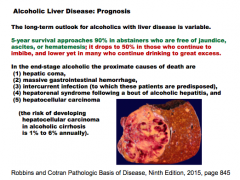
|
|
|
What are some components of Mallory-Denk bodies |
Cytokeratin 8 and 18 => ubiquitin normally recycles but gets stuck to them due to toxicity of alcohol
NOT SPECIFIC FOR ALCOHOLIC LIVER DISEASE
Rounder, more oblong than a1AT (more rounded) |

